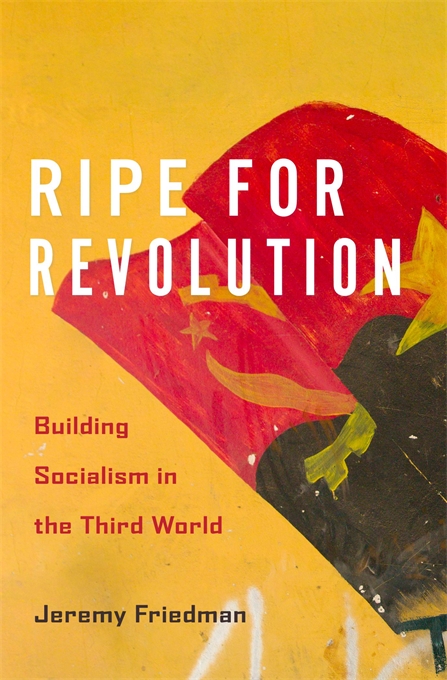In an excerpt from his new book Ripe for Revolution: Building Socialism in the Third World, Harvard Business School professor Jeremy Friedman explores the role that ideology played in the evolution of socialist countries in the developing world during the 20th century.
Editor’s note: The current debate in economics seems to lack a historical perspective. To try to address this deficiency, we decided to launch a Sunday column on ProMarket focusing on the historical dimension of economic ideas. You can read all of the pieces in the series here.
How do we understand socialism as an international phenomenon? How does it compare to the international history of capitalism, which is increasingly a focus of historical study, or to the international histories of other political and economic forms and ideas? What makes socialism distinct is that, at least in its Marxist forms, it is self-consciously and necessarily both international and internationalist.
Fred Halliday, in Revolution and World Politics, has identified this internationalism as endemic to the revolutionary era that began with the French Revolution of 1789, and he places internationalist ideas into one of three categories: utopian, calculated, and instrumental. Utopian internationalist ideas are those that are incommensurate with real capabilities, calculated ideas are commensurate with real capabilities, and instrumental ideas are those where the true intention is merely to use internationalism as a cover for national interest. While there is merit to such a classification, there might be a temptation to classify socialist countries’ internationalism as a consequence as utopian, calculated, or instrumental.
It might make more sense, therefore, to analyze the internationalist elements present in the foreign policy of each socialist country in terms of beliefs, capabilities, and interests. When the policies of two socialist countries diverge, such as the Chinese and Soviet attitudes toward the Indonesian Communist Party possibly attempting to seize power by force, it might be useful to ask whether and how much the divergence can be attributed to divergence in beliefs, capabilities, or interests.
While this scheme has some potential application to the foreign policy of almost any state, its utility in the case of socialist states that professed some version of socialist internationalism is enhanced by their claim to a common ideology. Kathleen Knight, based on a study of the use and interpretation of the term ideology in political science during the twentieth and early twenty-first centuries, argues that political scientists have converged on a core definition of the term as “a coherent and relatively stable set of beliefs or values.” While this definition emphasizes the intellectual structure of ideology, it seems to miss the function that ideology serves.
Having an ideology allows one to make faster, surer judgments about the world, to delineate friend from foe, progress from regression, and to determine the normative as well as the positive value of different options. An ideology facilitates this in part by being an integrated structure, not just a set of beliefs, so that given beliefs or values can be prioritized over others based on current need in order for the ideology as a whole to continue performing this function. As Knight explains, political scientists have, in the context of American politics, come to see political ideologies as part of a spectrum, in which to claim one ideology means to delineate oneself from one’s ideological opponents. As long as ideological identification is determined by such spatial demarcations, it is easy to see how certain beliefs or values can be jettisoned while maintaining one’s ideological identity as, for instance, a “liberal” or “conservative.”
It is similarly possible to imagine that if one’s ideological structure identifies one as a socialist in opposition to capitalism, one can jettison certain beliefs—for instance, that markets are always in tension with central planning—without abandoning the larger ideology. Ideology therefore might be better defined as a systematically simplified way of understanding reality that facilitates judgment and action. Ideology allows its holders to identify the salient factors in a given situation and use those to determine what to do next.
This framework helps make sense of a socialist world in which different socialist countries, claiming adherence to the same ideology, could make different judgments in foreign and domestic policy without betraying that ideology. Defining themselves in contradistinction to a system of imperialistic capitalism (and believing in the ultimate victory of socialism over that system), different sets of beliefs, capabilities, and interests could produce different conclusions. Soviet belief in the necessity of avoiding full-scale war, and the utility of a uniform and cohesive international communist movement, not only matched Soviet interests but reflected Moscow’s best estimation of how to maximize Eastern Bloc capabilities. China’s focus on violent disruption in the developing world reflected its capabilities in terms of what sorts of aid it was best equipped to provide, as well as its interests in terms of self-preservation and geopolitical flexibility. Similar analyses could be made of Yugoslavia’s global role based on its vision of a nonaligned developing world, East Germany’s focus on recognition and competition with West Germany, Cuba’s desire to overstretch American resources and divert Washington’s focus, and even Romania’s attempt to distance itself from the Warsaw Pact by building its own constituency in the developing world.
“as the ultimate victory of the world revolution continually receded beyond the horizon and the process of establishing socialism as a world system became ever more prolonged, the shifts necessitated by the Cold War struggle took their toll on the socialist project itself.”
These beliefs, capabilities, and interests were not constant during the course of the Cold War. To take just one example, as Cuba’s relationship with the Soviet Union improved in the 1970s, the willingness of the Cuban leadership to entertain the possibility of a parliamentary path to socialism grew, as was evidenced by Fidel Castro’s attempts to rein in the “adventurism” of the Chilean Socialist Party. But these adjustments of beliefs, capabilities, and interests did not therefore signal a shift in ideology. Cuba’s strategy in Chile was still focused on the goal of establishing a socialist regime in Latin America as a blow against American-led imperialism. Yet as the ultimate victory of the world revolution continually receded beyond the horizon and the process of establishing socialism as a world system became ever more prolonged, the shifts necessitated by the Cold War struggle took their toll on the socialist project itself.
While the ideology was flexible, it was not infinitely malleable. In the course of this process of trial and error to develop a model of socialist development for the Third World, how to get to “social control of the means of production” and what that might ultimately mean began to shift, but not beyond recognizable bounds.
For the Soviets, the process began as a sort of Stalinism for export, with an emphasis on the development of heavy industry via the state sector, enabled by the provision of aid from the socialist bloc. This often dovetailed with the statist plans and inclinations of leaders in places such as Egypt or India, but as can be seen in the case of Indonesia, Soviet diplomats at times took the initiative in pushing developing countries toward such projects. Even at this stage, though, Joseph Stalin’s recommendations to the Indonesian communists on the question of agricultural collectivization demonstrated a willingness to depart from the script he himself wrote. For the Soviets, a strategy of development based on state investment in heavy industry held both economic and political import, because it would create a working class, eventually leading to the creation of a communist party. For the Chinese, such a strategy was backward. Socialist economic development could not precede the political conquest of power, and Beijing’s strategy in Indonesia was predicated on the latter.
In any case, Moscow’s initial model of state-led industrialization accomplished with aid from socialist countries failed to produce the desired results, economically or politically. For the Soviets it was costly, both in terms of economic resources and in terms of its relations with developing countries, which did not appreciate this degree of interference. The failure of this model—in West Africa, in particular—led others to seek alternative pathways to socialist development. Tanzania countered with a model in which self-reliance replaced external aid, and agricultural development preceded industrial investment. Tanzania’s socialist experiment, led by its charismatic president Julius Nyerere, made it a darling of the international Left. Socialists of all sorts came to participate in one way or another, teaching at the University of Dar es Salaam or helping out in the new ujamaa villages.
The economic failure of ujamaa has had many diagnoses. The one favored by Nyerere, and by many on the Left persuaded by the claims of dependency theory at the height of the Third World movement in the 1970s, was that self-reliance, especially for a country that depended upon commodity production, was simply unfeasible given the international terms of trade. The Soviets instead turned back to the market, seeing small-scale trading focused on increasing agricultural productivity, along with the attraction of foreign investment in industry—all within limits, of course—as a necessary stage on the path to a socialist future.
Excerpted from Ripe for Revolution: Building Socialism in the Third World by Jeremy Friedman, published by Harvard University Press. Copyright © 2021 by the President and Fellows of Harvard College. Used by permission. All rights reserved.
Learn more about our disclosure policy here.







